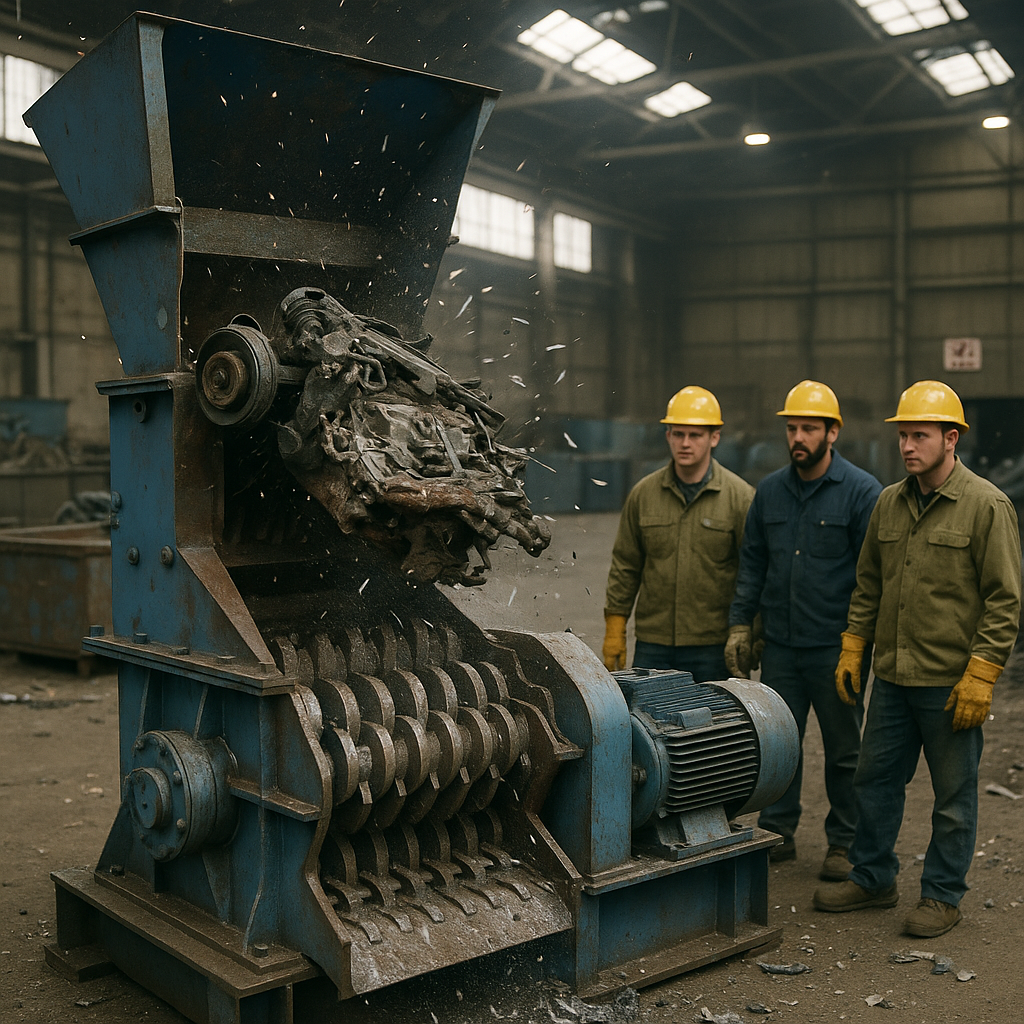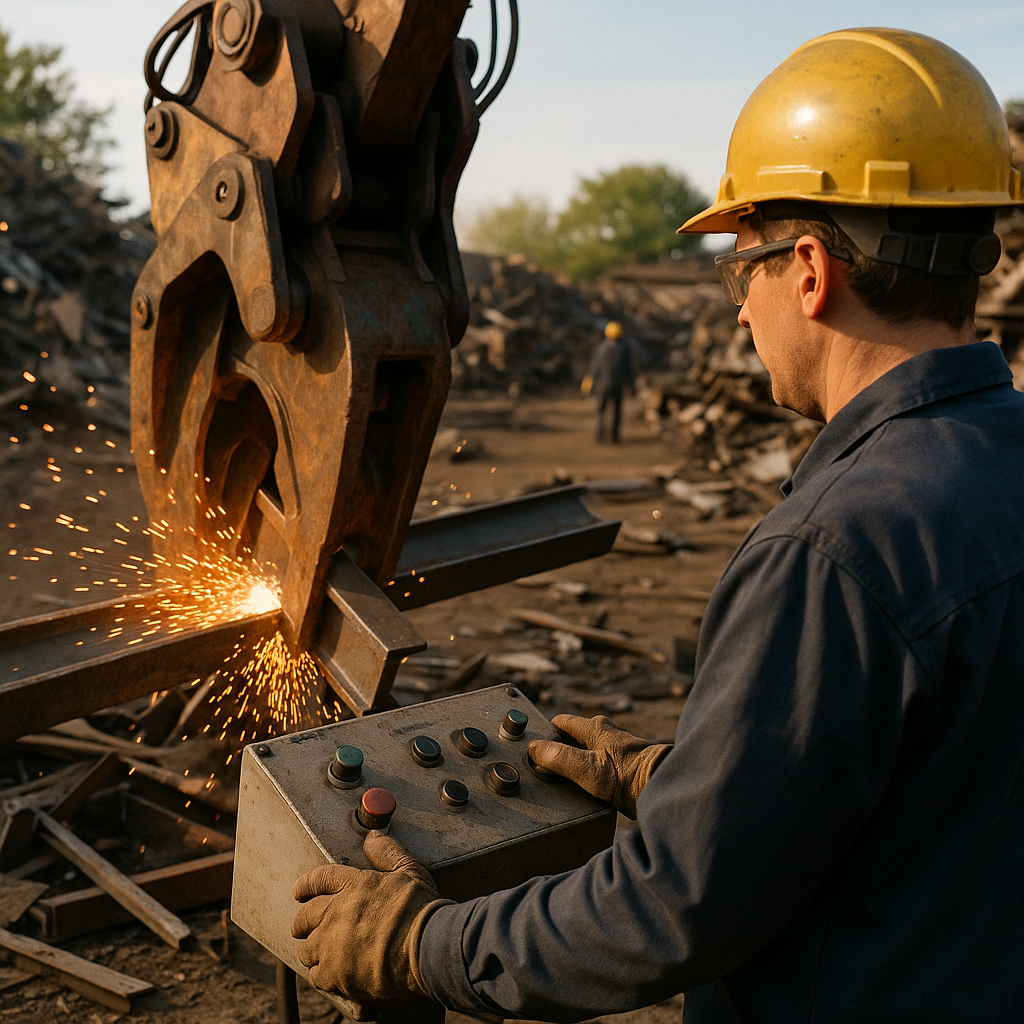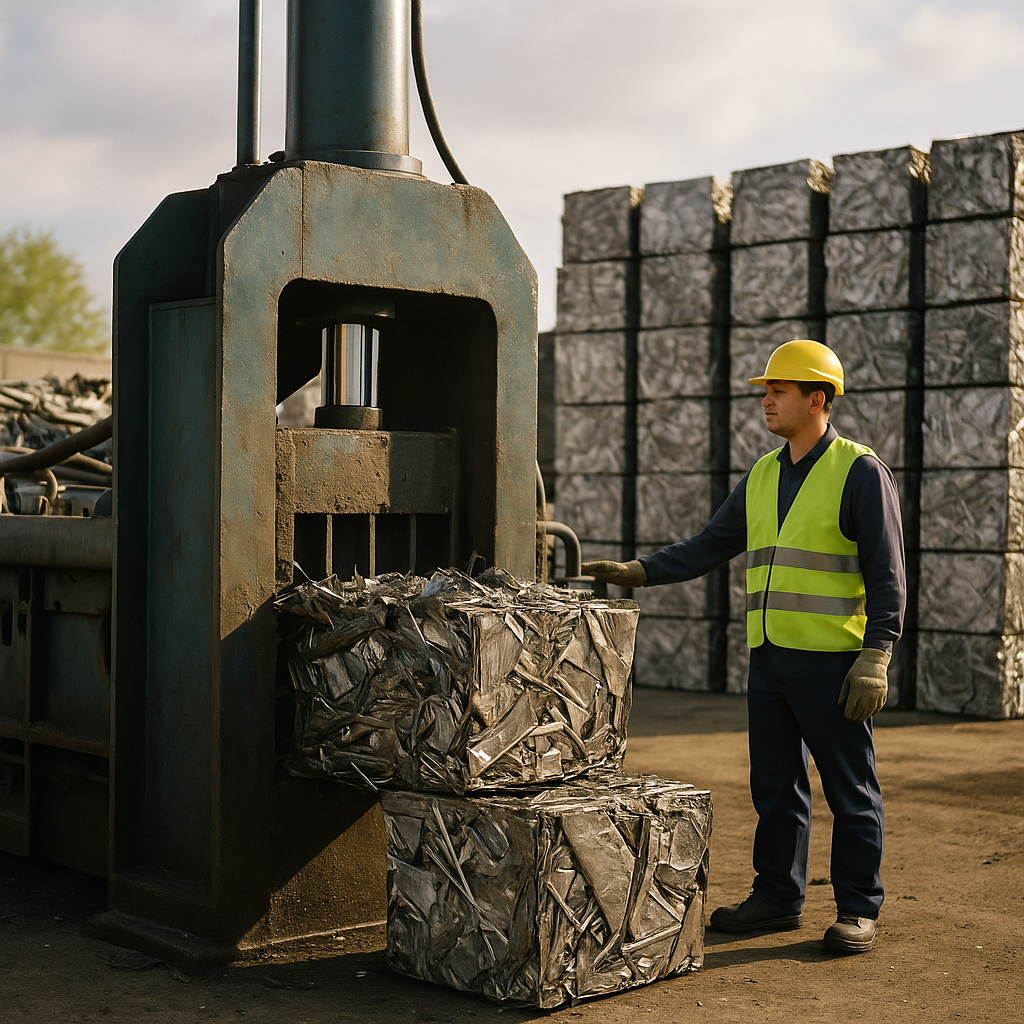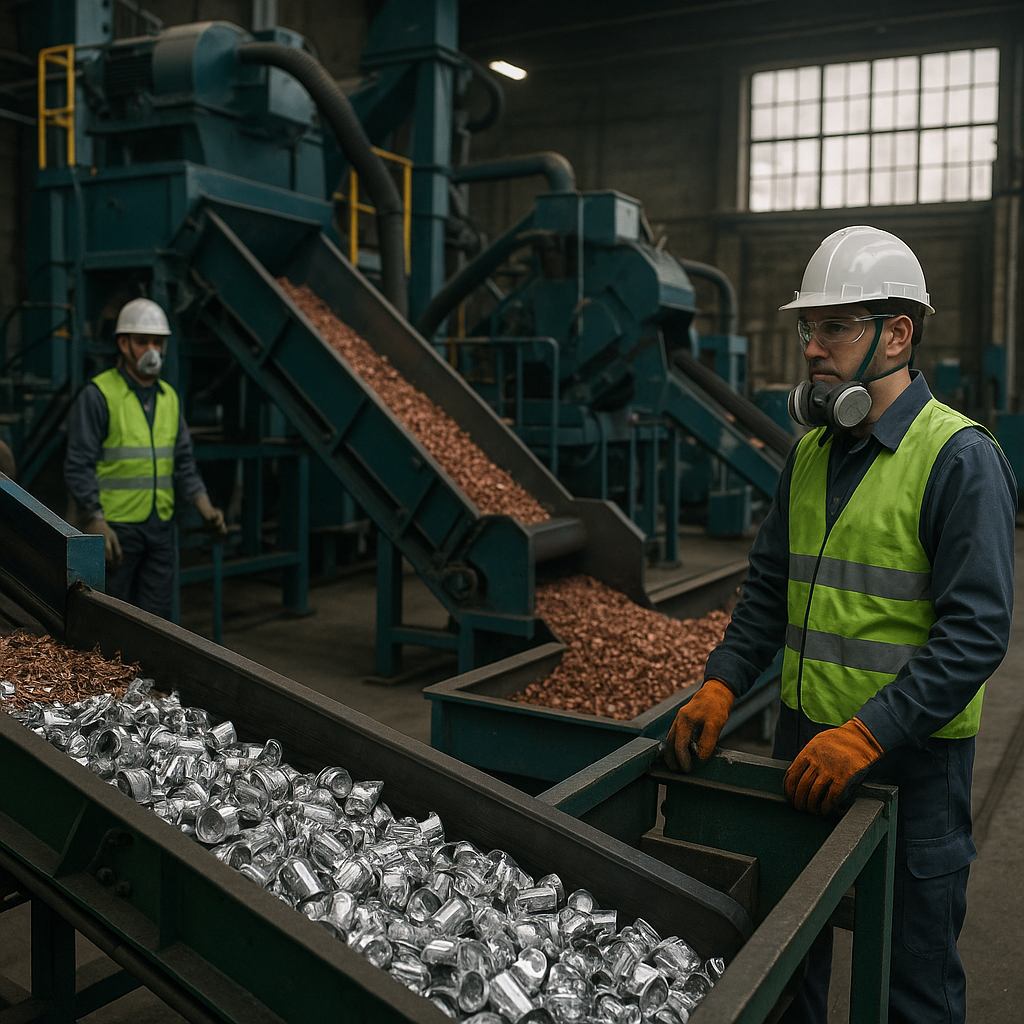5901 Botham Jean Blvd, Dallas, TX 75215
What Are the Key Scrap Metal Recycling Equipment Options?
August 16, 2025The backbone of any effective metal recycling operation is its specialized equipment. Modern scrap yards rely on several core machinery types to transform metal waste into valuable resources. These essential tools include industrial shredders, scrap shears, baling presses, and specialized non-ferrous processing equipment.
Shredders serve as the workhorses of large-scale operations, processing significant volumes of scrap metal with powerful cutting mechanisms. Scrap shears are precision tools, cutting larger pieces of metal into manageable sizes with their hydraulic blades. Baling presses address logistics by compressing loose scrap into dense, uniform bales that enhance transport efficiency and storage space.
Non-ferrous recycling equipment completes the processing lineup with specialized machinery designed to separate and recover valuable metals like aluminum, copper, and brass from mixed material streams. Each equipment type plays a distinct role in converting metal waste into marketable commodities ready to reenter the manufacturing cycle.
How Do Shredders Enhance Scrap Metal Recycling?

Shredders are crucial in high-volume scrap metal recycling operations. These powerful machines transform bulky scrap into uniform, manageable pieces, streamlining the entire recycling process. With over 150 industrial shredders installed worldwide, companies like Danieli Centro Recycling have transformed how facilities process large volumes of both ferrous and non-ferrous materials.
The primary function of metal shredders is size reduction. When end-of-life vehicles enter a recycling facility, they pose significant handling challenges in their original form. Shredders break these vehicles into smaller fragments, separating components and making valuable metals more accessible. A single industrial shredder can process over 100 tons of scrap metal per hour, greatly accelerating the return of materials to the manufacturing cycle.
Modern metal shredders excel at processing diverse materials. Beyond vehicles, they handle consumer appliances like refrigerators, washing machines, and dishwashers efficiently. Industrial equipment, manufacturing scrap, and structural metal waste all pass through these machines, where powerful hammers and cutting mechanisms reduce them to fragments. The shredding process also enhances the separation of ferrous metals from non-ferrous metals like aluminum, copper, and brass, significantly improving recovery rates.
Beyond size reduction, shredded materials are more valuable to recycled metal buyers because they are predictable and easier to work with. Uniform pieces created by industrial shredders melt more efficiently in furnaces, requiring less energy during remelting. Additionally, the reduced volume allows for more efficient transportation and storage, cutting logistics costs throughout the recycling supply chain.
Leading manufacturers like Danieli Centro Recycling, SSI Shredding Systems, and Granutech-Saturn Systems produce specialized shredders tailored to specific materials and throughput requirements. These range from hammer mill shredders that use high-torque rotational force to pre-shredders that handle initial size reduction of particularly large or dense materials. Technology continues to advance, with newer models incorporating hydraulic systems for better precision and control when processing tough materials.
By incorporating metal shredders into recycling operations, facilities can process materials faster, recover more valuable components, and significantly reduce the environmental impact of metal waste. This efficiency is crucial as global demand for recycled metals rises, driven by both economic and environmental factors.
What Role Do Scrap Shears Play in Metal Recycling?

Scrap shears are the essential workhorses of metal recycling facilities. These powerful machines cut large, unwieldy pieces of metal into smaller, manageable sizes that can be more efficiently processed, transported, and melted down. Without these vital tools, recycling bulky metal items would be significantly more challenging and less economical.
Hydraulic scrap shears have been central to the metal recycling industry for over four decades. Their enduring presence highlights their reliability and effectiveness in demanding industrial applications. These machines use hydraulic pressure to generate significant cutting force, allowing them to slice through thick metal with precision and efficiency.
The versatility of scrap shears makes them indispensable in recycling operations. They can process a variety of scrap metals, including steel bars, aluminum, profiles, and bulky scrap. This adaptability allows recycling facilities to handle diverse material streams without the need for multiple specialized cutting tools.
Different types of scrap shears cater to specific needs within the recycling process. Alligator shears, named for their resemblance to an alligator’s jaw, are common in scrap yards for processing mixed metals. Guillotine shears deliver precise cuts on flat materials, and for heavier applications, gantry shears can handle materials like I-beams, steel bars, and even automobile bodies.
The size reduction function of scrap shears offers several important benefits for recycling operations. Smaller pieces enable more efficient furnace loading, reducing energy consumption during melting. They also facilitate better sorting and separation of different metal types, improving the purity and value of the recycled material. Additionally, compact pieces optimize transportation capacity, reducing the environmental impact and cost of moving materials between facilities.
Modern scrap shears incorporate advanced features like automatic sequence valves, hydraulic hold-downs, and adjustable jaw openings to enhance their performance. These innovations have improved cutting efficiency, operator safety, and equipment durability, making today’s machines more productive than their predecessors.
How Do Baling Presses Improve Scrap Metal Handling?

Baling presses transform loose, bulky scrap metal into dense, uniform bales through powerful hydraulic compression. This process significantly enhances the recycling chain, from collection to processing.
The most immediate benefit is the dramatic reduction in volume. Loose scrap metal can occupy up to four times the space of properly baled material. By compressing this material into dense blocks, recycling facilities can store significantly more inventory in the same space, effectively maximizing their available real estate.
Transportation Efficiency and Cost Reduction
Transportation costs represent one of the largest operational expenses in scrap metal recycling. Baling presses directly address this challenge by increasing load density. A truck loaded with loose scrap might only utilize 25% of its weight capacity due to the material’s bulky nature. In contrast, properly baled scrap can maximize both volume and weight limits.
This efficiency translates to fewer trips, reduced fuel consumption, and lower transportation costs. For recycling operations handling high volumes, these savings can reach 20-30% of transportation expenses. Additionally, uniform bales are easier to stack securely, reducing the risk of shifting loads during transport and improving safety compliance.
Foundry Operations and Furnace Performance
For foundries and metal processors, bale quality significantly impacts operational efficiency. Uniform, high-density bales produced by modern baling presses provide consistent material input for furnaces, leading to more predictable melting cycles and improved production planning.
Well-compressed bales also melt more efficiently since the density reduces air pockets that can create oxidation issues during the melting process. This results in better metal recovery rates and reduced energy consumption per ton processed. Some foundries report up to 15% improvement in furnace throughput when using properly baled scrap versus loose material.
Additionally, consistent bale dimensions allow for precise charging of furnaces, optimizing each melt cycle and reducing unnecessary downtime between batches.
Material Handling Improvements
Throughout the recycling process, baled scrap is substantially easier to handle than loose material. Standardized bale dimensions allow for efficient storage systems, with bales that can be stacked securely to maximize vertical space. This organization reduces workplace hazards by eliminating scattered sharp metal pieces that can cause injuries.
Modern material handling equipment like forklifts and grapples can move multiple bales simultaneously, improving labor efficiency and reducing the time needed to load and unload shipments. For large recycling facilities, this can translate to handling twice the volume of material with the same staff resources.
Baling presses also play a crucial role in quality control. The compression process helps separate different metal types and removes contaminants, resulting in cleaner, more valuable scrap. This sorting efficiency means downstream processors receive more consistent material, improving their operational planning and reducing processing costs.
For businesses of all sizes in the recycling industry, baling presses represent a critical tool for optimizing operations, reducing costs, and improving safety. The initial investment in quality baling equipment typically delivers returns through immediate operational improvements and long-term efficiency gains throughout the entire scrap metal handling process.
What Equipment is Used for Non-Ferrous Metal Recycling?

The recycling of non-ferrous metals requires specialized equipment designed to handle the unique properties of materials like aluminum, copper, and brass. With increasing consumer and light industrial waste streams, recycling facilities need efficient systems to separate and process these valuable materials.
Eddy current separators are pivotal in non-ferrous metal recovery. These machines use powerful magnetic fields to repel non-magnetic metals, effectively separating them from non-metallic waste. This technology is crucial for processing mixed waste streams where aluminum cans, copper wiring, and brass components are mixed with other materials.
Optical sorters are another significant advancement in non-ferrous recycling technology. These sophisticated systems use cameras and sensors to identify metal types based on visual properties. When paired with air jets or mechanical separators, optical sorters can accurately separate copper from brass or aluminum from other non-ferrous metals, even at high speeds.
Specialized shredders for non-ferrous applications play a vital role in size reduction. Unlike their ferrous counterparts, these shredders have cutting mechanisms optimized for softer, more malleable metals. Twin-shaft shredders with custom blade configurations can efficiently process everything from aluminum siding to copper pipes while minimizing material loss.
Balers and briquetting machines complete the processing cycle by compacting separated non-ferrous metals into dense, uniform packages. Modern balers can achieve significant compression ratios, reducing transportation costs and creating standardized bundles that command premium prices from smelters and refiners.
For finer materials like metal turnings or shavings, specialized metal recovery systems combine magnetic separation, density sorting, and sometimes fluid-based technologies to capture even the smallest valuable particles. These systems are increasingly important for maximizing recovery from production waste.
As scrap volumes rise, automated sorting systems that combine multiple technologies are becoming more common. These integrated solutions might incorporate conveyor systems, magnetic separators, eddy current units, and optical sorters in a single processing line to maximize throughput and recovery rates.
The development of more efficient recycling equipment underscores the growing economic and environmental significance of non-ferrous metal recovery. With primary metal production requiring significant energy inputs, recycling technologies that effectively process aluminum, copper, and brass help conserve natural resources while reducing the carbon footprint of the metals industry.
Conclusion: Choosing the Right Scrap Metal Recycling Equipment

Selecting the right scrap metal recycling equipment is crucial, dependent on factors such as the types of metals processed, material volume, and specific operational needs. Whether your focus is on ferrous or non-ferrous metals, high or low volumes, these elements influence your equipment choices.
The scrap metal recycling industry utilizes diverse equipment, each fulfilling specific roles. Shredders reduce bulky materials, while balers compress metals for easier transport. Alligator shears and guillotine shears cut heavy metals beyond the capacity of other equipment. Magnetic separators efficiently distinguish ferrous from non-ferrous metals, and specialized machinery targets materials like copper, aluminum, and brass.
To maximize scrap metal value, investing in the right technology combination is vital. Effective equipment can reduce waste volume by up to 90%, reclaim cutting fluids, and enhance the value of processed metals. Such efficiency bolsters sustainability efforts and strengthens participation in the circular economy.
For tailored advice on selecting the best recycling equipment for your facility, reach out to Okon Recycling at 214-717-4083.
